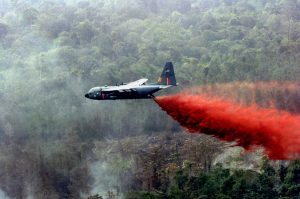Bush fires in Australia
Surely you have seen some pictures of fire-fighting planes in the media over the last few weeks, which are doing their utmost to fight the bush fires with so-called retardants.

Bushfires, intentional or unintentional, contribute much more to climate change than is known, because when wood burns, the fixed carbon produces the greenhouse gas CO2.
A new study in the trade journal “Science” shows the dramatic effects this has on climate change. “We estimate that slash-and-burn contributes one-fifth to the greenhouse effect caused by humans,” says Thomas Swetnam of the University of Arizona in Tucson, one of the authors of the study. It is absolutely clear that fires are one of the main accelerators of climate change.
The rise in temperature then favours further major fires – a vicious circle. Incidentally, this is a threat that will probably also affect German forests in the long term.
In total, more than 1.1 million hectares of land have already been affected in eastern Australia in recent days. There are about 70 fires in New South Wales, 50 of which have been contained.
Sydney is also threatened by the fires.
Here you can see a video that shows in an impressive way how serious the danger is and by what measures the fire brigades try to control the fires. Fire brigade warning: “For God’s sake, stay away from the bush“!
Without these courageous firefighters we would all be lost in a fire. At this point I would like to thank everyone who is involved in the voluntary fire brigade or works as a firefighter. Thank you very much!
And in this video you can see how the fire engines work feverishly with retardants to protect as many properties, houses, barns as possible and of course try to extinguish the fires. Fire retardant for houses and properties in Sydney. By 9NewsAus.
For your information:
Flame retardants used in forest fires are usually a mixture of water and chemicals – ammonium salts, phosphates and sulphates – which have flame-retardant properties and are intended to wet the area and chemically retard the course of a fire through vegetation.
Typically, it is colour-coded – with red iron oxide or non-toxic organic dyes decomposing under UV light, so that the application area is visible from the air.
However, gel-based retardants complying with NFPA Standard 1150 are also used. These are coloured in other colours to distinguish them from the traditional red retardants. The gels and their dyes are designed to biodegrade naturally. Phos-Chek is a brand of long-term retardants currently approved for use in wilderness areas. Phos-Chek also has a consumer-based fire retardant spray called Wildfire Home Defense, which is effective immediately after use and remains effective until washed with heavy water.
In fire-fighting vehicles, foam compounds, so-called Class A Foam compounds, are generally used.
Today, this Class A Foam is the undisputed state of the art in the USA, Canada and partly also in Australia. It is accepted by municipal fire brigades, forestry and fire brigades as well as by ecologists and is mainly used to fight or seal off uncontrolled and controlled vegetation fires. The Class A Foam foams approved in the USA have been developed exclusively for fighting solid fires (wood, straw, tyres, coal).
As you can see – retardants are essential for survival, not only for humans, animals and property – but also for our planet in the fight against climate change!
